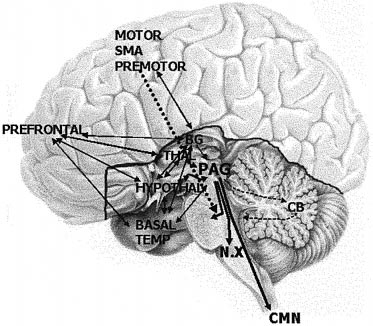What is the Cerebral Effects Continuous Laughter Called
Were does Humor and Laughter Reside in the Brain?

That is a difficult question for two reasons:
- The exact meaning of the terms `laughter,' `humour' and `funny' have been formulated for individual studies, a broad consensus on their exact meanings has yet to be reached. Are tickling and contagious laughter one and the same or manifestations of particular kinds of humour? Is humour a kind of perception or is humour `something' that is produced? Or is it both?
- The meaning of these terms may vary over time. What was funny 20 years ago may not be funny today. Moreover, definitions vary not only with time but also among languages and cultures.
The reactions to humor is a complex reaction comparable to e.g crying and pain. The reaction is mainly described as a two phase response the incongruity theory.
According to the incongruity theory, humor involves the perception of incongruity or paradox in a playful context. For something to be funny, two stages can be distinguished in the processing of humorous material. In the first stage, …..the perceiver finds his expectation about the text disconfirmed by the ending of the joke…..In other words, the recipient encounters an incongruity –the punch-line. In the second stage, the perceiver engages in a form of problem-solving to find a cognitive rule which makes the punch-line follow from the main part of the joke and reconciles the incongruous parts'. Other researchers have called these stages `surprise' and `coherence'.
A more precise description of humor and laughter is a 5 stage model more appropriate for neurologists and neuroscientists:
- it contains the potential elements of humour
- it is perceived as humorous
- it leads to exhilaration
- the motor expression of laughter
- and to an elevated mood.
This makes the localization of humor and laughter in the brain complex. Humor and laughter is a complicated process. Each of these elements may have its own cerebral substrate.
The perception of humor is dependent on certain faculties of the brain, such as attention, working memory, mental flexibility, emotional evaluation, verbal abstraction and the feeling of positive emotions. Given these involvements, theory dictates that (at least) those regions of the brain associated with these processes should be active in the perception of humor.
Humor and laughter need a neural network in which frontal and temporal regions are involved in the perception of humor. These, in turn, would induce facial reactions and laughter mediated by dorsal brainstem regions. These reactions would be inhibited by the ventral brainstem, probably via frontal motor/premotor areas.
One of the latest publications discusses the results of fMRI research done by three different research groups. They all found the human reward system in the brain involved with humor. This system mainly uses dopamine as it's neurotransmittor. That's why everyone loves to laugh. The activation of this system, the mesolimbic regions represents the pleasurable component of humor.
Now, a recent fMRI study has found mesolimbic reward activation associated with humorous cartoons, providing a neurobiological link between theories of humor and hedonic processes in the brain.
More recent research found that both men and women share an extensive humor-response strategy as indicated by recruitment of similar brain regions. They also found a difference between men and women as far as brain activation in a fMRI study was concerned around humor.
Females activate the left prefrontal cortex more than males, suggesting a greater degree of executive processing and language-based decoding. Females also exhibit greater activation of mesolimbic regions, including the nucleus accumbens, implying greater reward network response and possibly less reward expectation. These results indicate sex-specific differences in neural response to humor with implications for sex-based disparities in the integration of cognition and emotion.
Conclusion
We are only starting to understand a small particle of an important subject such as humor and laughter. What is your opinion about this kind of research, a waist of time and money? Important for future therapies? Let me know.
![]()
B. Wild (2003). Neural correlates of laughter and humour Brain, 126 (10), 2121-2138 DOI: 10.1093/brain/awg226
G Berns (2004). Something funny happened to reward Trends in Cognitive Sciences, 8 (5), 193-194 DOI: 10.1016/j.tics.2004.03.007
E. Azim (2005). Sex differences in brain activation elicited by humor Proceedings of the National Academy of Sciences, 102 (45), 16496-16501 DOI: 10.1073/pnas.0408456102

davenportwainewhim.blogspot.com
Source: https://www.shockmd.com/2009/01/07/were-does-humor-and-laughter-reside-in-the-brain/
0 Response to "What is the Cerebral Effects Continuous Laughter Called"
Enviar um comentário